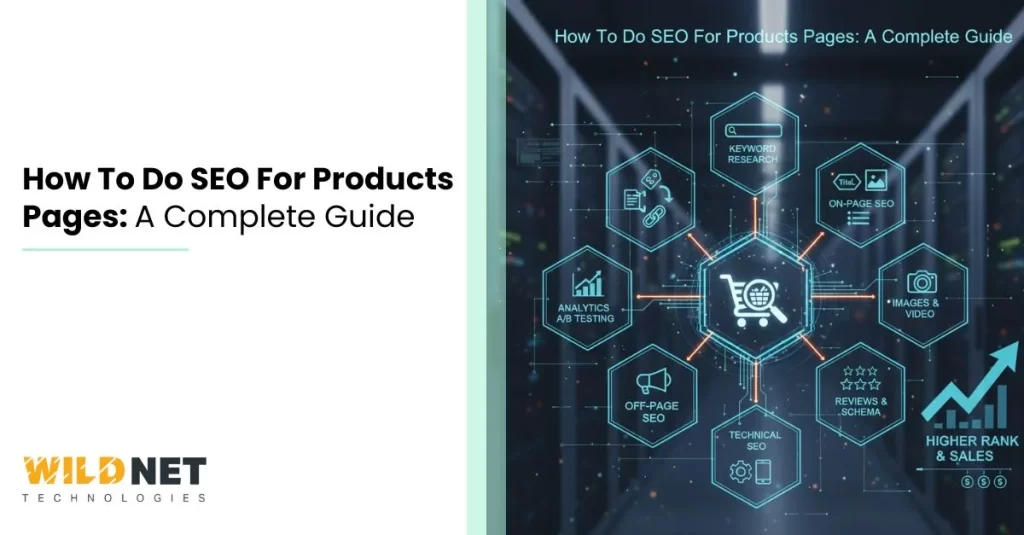In the digital age, product pages are the heart of e-commerce websites. They showcase your offerings and drive sales. But how do you ensure they stand out in search results?
SEO for Product Pages is crucial — it helps your products get noticed by potential buyers. Without it, your pages might get lost in the vast sea of online content.
Understanding search engine basics is the first step. It lays the foundation for effective product page optimization, which helps you enhance visibility and attract qualified traffic.
Keyword research is another key element. It guides you in choosing the right terms to target, ensuring your product pages reach the right audience.
Crafting compelling titles and descriptions is also vital. They attract clicks and improve your search rankings. High-quality content is essential for engaging users and search engines alike.
In this guide, we’ll explore essential SEO strategies. These tactics will enhance your product pages and boost your e-commerce success.
Understanding Search Engine Basics for Product Pages
Understanding search engine basics is vital for optimizing product pages. It forms the backbone of product page SEO. Search engines use algorithms to decide page rankings, affecting visibility and traffic.
These algorithms consider multiple factors. From keywords and content quality to mobile-friendliness, many elements influence search rankings. Knowing these helps tailor your product pages effectively.
The importance of keywords can’t be overstated. Keywords signal to search engines what your page is about. Researching and using effective keywords is essential for relevancy.
Site structure is also crucial. A user-friendly layout ensures search engines can crawl and index your site efficiently. Better site navigation leads to improved search rankings.
Engagement metrics matter, too. Search engines track user interactions, such as time spent on a page. High engagement can boost your product page’s visibility.
In essence, optimizing for search engines requires understanding several key aspects:
- Keywords
- Site structure
- Content quality
- Engagement metrics
Mastering these basics strengthens your product page SEO efforts, paving the way for more traffic and increased sales.
The Importance of Product Page SEO in E-commerce
SEO for Product Pages is a critical component of e-commerce success. It enhances visibility in search results, driving more organic traffic to your site.
Optimized product pages can significantly boost click-through rates. When pages appear higher in search results, they attract more potential buyers. This increased visibility often translates into higher sales.
Effective SEO practices help retain customers in addition to attracting new visitors. Well-organized and optimized pages offer a better user experience, encouraging repeat visits, which often results in increased customer loyalty.
E-commerce is fiercely competitive. Standing out requires leveraging SEO strategies to improve your product pages. This approach helps differentiate your online store from countless others.
Moreover, optimized product pages support brand authority. Consistent and high-ranking product pages build trust among consumers. Trust, in turn, fosters long-term relationships and enhances brand credibility.
Key reasons for product page SEO importance include:
- Increased visibility
- Improved user experience
- Competitive edge
- Brand authority and trust
Focusing on these aspects can lead to long-term success in the e-commerce space.
Keyword Research for Product Pages
Keyword research is foundational for effective SEO. Identifying the right keywords ensures your product pages reach potential buyers.
Begin by brainstorming relevant terms for your products. Consider what users might search for when looking for items you offer. This initial step helps shape your keyword strategy.
Leverage tools like Google Keyword Planner or SEMrush. These platforms offer insights into search volume, competition, and related keywords. They’re invaluable in fine-tuning your keyword list.
Long-tail keywords are particularly valuable in product page SEO. These phrases are more specific and often less competitive, attracting highly targeted traffic.
Analyzing competitors can also reveal keyword opportunities. Examine the terms that drive traffic to their product pages. This analysis can identify gaps or unexplored niches for you.
Furthermore, understanding your audience’s language is crucial. Use terms and phrases your customers typically use. This connection can improve user experience and boost search rankings.
Keep your keyword strategy evolving. Regularly update your list based on new products, trends, or changes in search behavior. This approach ensures relevance and effectiveness.
How to Identify Primary and Secondary Keywords
Identifying primary and secondary keywords involves understanding product and audience needs. Primary keywords are high-impact and central to your products.
Start with a seed keyword related to your product. Expand using keyword research tools to find related terms with search potential.
Secondary keywords provide additional context. They support primary keywords and capture broader search intent.
Organize identified keywords effectively. Consider:
- Primary keywords for titles and main headings.
- Secondary keywords within descriptions and subheadings.
Competitor analysis is helpful. Check their top-performing keywords for potential additions to your strategy.
Integrating Keywords Naturally
Keyword integration requires a balance between optimization and readability. Forced usage can deter visitors and hurt rankings.
Focus on naturally weaving keywords into content. Flow and coherence should guide their placement.
Prioritize user experience over keyword density. Aim for seamless integration within product information.
Consider these natural integration tactics:
- Use keywords in product titles and descriptions.
- Include them in header tags and image alt text.
- Distribute keywords evenly throughout the content.
Maintain a conversational tone. This approach encourages engagement and improves user satisfaction.
Crafting Compelling Product Titles and Meta Information
Product titles and meta information play a crucial role in both click-through rates and search rankings. They are the first elements potential customers notice when browsing search results.
For effective SEO for Product Pages, titles should be clear, descriptive, and include primary keywords naturally. This helps both search engines and users understand exactly what your product offers.
Meta descriptions provide a concise overview of the product, ideally around 150–160 characters. They should be engaging and informative and can include secondary keywords to enhance relevance.
Well-crafted titles and meta descriptions compel users to click. They must align with user intent and deliver value immediately, making compelling copywriting essential for high-performing product pages.
Utilize tools like Yoast SEO for insights on title and meta length. Such tools provide visual guidelines for optimal content creation.
Review and update product titles and meta descriptions regularly. Changes in trends or inventory require fresh, relevant content to stay competitive in search results.
Writing SEO-Friendly Product Titles
Crafting SEO-friendly titles involves being strategic with words. Optimal titles are clear, keyword-focused, and resonate with users.
Use primary keywords early in titles. This placement emphasizes relevance to both search engines and users.
Keep titles under 60 characters. This length ensures complete visibility in search results.
Avoid keyword stuffing. Instead, focus on clarity and directness.
Tools like Ubersuggest can help refine keyword choices. They’re a key resource for SEO-driven title development.
Optimizing Meta Descriptions for Click-Throughs
Optimizing meta descriptions is all about enticing the click. They must engage and provide clear information quickly.
Use active language that prompts action. Words like “discover,” “explore,” or “learn” encourage users to click.
Incorporate a call-to-action (CTA). Phrases such as “find out more” or “shop now” work effectively.
Highlight unique selling points in the description. Stand out from competitors by mentioning special features or offers.
Meta descriptions should include secondary keywords naturally. This inclusion supports SEO objectives without sacrificing readability.
Regular updates to meta descriptions are essential. This practice maintains relevance and responds to dynamic market shifts.
Creating Unique and Persuasive Product Descriptions
Product descriptions are your digital sales pitch. They provide essential details and persuade potential buyers.
A well-crafted product description should be informative yet engaging. It must highlight key features and benefits. This clarity aids in decision-making.
Using plain language helps, but don’t shy away from persuasive words. Expressions like “elevate,” “transform,” or “experience” can make an impact.
Focus on what sets your product apart. Distinguishing features or benefits make it stand out in a crowded market.
Incorporate relevant keywords naturally within the text. This practice boosts search visibility without compromising readability.
Consider the customer’s perspective. Address questions or concerns they might have. What would they want to know?
A bullet-point list can effectively summarize important features or benefits. This list format enhances readability and helps users find information quickly.
- Focus on clarity and benefits.
- Use persuasive language strategically
- Highlight key features effectively
Avoiding Duplicate Content
Duplicate content can harm your SEO efforts significantly. It’s essential to ensure every product description is unique.
Write distinct descriptions for similar products. Tailor your focus to specific features or benefits that differ.
Avoid copying manufacturer-provided content directly. Originality boosts your page’s SEO value and user interest.
- Ensure all content is unique
- Use original language and ideas
- Distinguish between similar products
Using Storytelling and Emotional Triggers
Storytelling can transform a bland description into a memorable one. An emotional connection creates a lasting impression.
Consider weaving a story around product use. This approach can engage customers on a deeper level.
Empathy through language creates connection. Words that evoke feelings make descriptions more relatable.
Incorporate storytelling elements to illustrate product benefits. Share how a product adds value or solves problems.
- Use descriptive, vivid language
- Evoke emotions and relate experiences
- Highlight user benefits through stories
Optimizing Product Images for SEO
Images play a crucial role in product page optimization. They enhance user experience and can boost your SEO effectiveness. Properly optimized images improve page loading times and help with search visibility.
Use high-quality images that accurately reflect your product. This authenticity builds trust with potential buyers and reduces return rates. Each image on your product page should serve a purpose.
Incorporate keywords into image file names. Descriptive names that include relevant keywords can improve image rankings. It’s a simple but effective SEO tactic.
Alt text is vital for accessibility and search engines. It provides context for the visually impaired and helps search engines understand your images. Always write concise, descriptive alt texts.
Consider using a combination of wide and close-up shots. This variety gives consumers a more comprehensive view of the product and provides more opportunities to include keywords in alt texts.
Never underestimate the impact of optimized images. They contribute to a positive user experience and support SEO strategies.
- Use high-quality, purposeful images.
- Incorporate keywords in file names
- Write descriptive alt text
Best Practices for Alt Text and File Names
Alt text needs to be clear and concise. It should also effectively describe what’s in the image. This practice is essential for both SEO and accessibility.
File names should also be descriptive. Avoid default names like “IMG1234”. Instead, use relevant keywords that describe the product or scene.
- Concise descriptions for alt text
- Use keywords in file names
- Avoid generic file names
Image Compression and Page Speed
Page speed affects both SEO and user experience. Compressed images load faster and improve site performance. Always aim for the smallest file size without losing quality.
Reduce image size using image compression tools. Several free options exist online to assist with this task. Reducing image size significantly speeds up page load times.
Regularly test your page speed. Continuous monitoring helps maintain optimal performance, and tools like Google PageSpeed Insights can offer valuable insights.
- Compress images without loss of quality.
- Utilize online tools for compression
- Monitor and maintain quick load times
Leveraging Structured Data and Rich Snippets
Structured data is a game-changer for product page SEO. It enhances search visibility by enabling rich snippets, which can display extra product details, boosting click-through rates.
Rich snippets provide potential buyers with information right in search results. They can show price, availability, and star ratings, making your product stand out. This visibility can lead to higher engagement and sales.
Implementing structured data ensures search engines understand your content better. This understanding leads to better indexing and can improve rankings. It’s a technical but essential part of SEO.
Creating rich snippets requires using schema markup. Google supports various schema types specific to products, improving result displays. Optimized snippets increase attraction and conversion potential.
Taking advantage of structured data benefits search engines and enhances the user’s search experience, making information more accessible and actionable.
- Improves search result visibility
- Enables rich snippets with product details
- Enhances user experience in search results
Implementing Product Schema Markup
Using product schema markup requires precision. It involves embedding code that communicates detailed product information to search engines. This markup facilitates rich snippet appearances.
Adding schema involves integrating JSON-LD or microdata into your HTML. JSON-LD is recommended for its simplicity and compatibility with various platforms. It can be added without altering the site design.
Testing your schema is crucial. Use tools like Google’s Structured Data Testing Tool to ensure proper implementation. This step verifies that search engines will recognize your markup.
- Integrate JSON-LD for simplicity.
- Test schema with Google’s tools
- Improves data for search engines
Mobile Optimization for Product Pages
Optimizing product pages for mobile devices is crucial. Mobile users now dominate web traffic, making mobile-friendly design a priority.
Mobile-friendly pages improve user experience and enhance SEO performance. This includes ensuring fast load times and easy navigation. Mobile optimization can significantly impact conversion rates.
Responsive design is essential. Your product pages should automatically adjust to various screen sizes, ensuring accessibility across all devices.
Test your pages on multiple devices to identify issues. Tools like Google’s Mobile-Friendly Test can offer insights into areas needing improvement. Regular testing ensures optimal performance for mobile users.
- Prioritize fast load times.
- Ensure responsive design
- Test with mobile-friendly tools
Enhancing User Experience (UX) and Page Design
A seamless user experience (UX) keeps visitors engaged. It encourages them to explore and convert. Start by simplifying navigation and layout.
Intuitive design reduces bounce rates. It helps users find products easily. Include prominent search features and filters for efficiency.
Visual appeal is key. Use high-quality images and consistent branding. This builds trust and supports brand recognition.
Consider usability. Optimize for speed and mobile compatibility. Fast, mobile-friendly pages enhance user satisfaction and SEO.
User feedback is valuable. Collect and analyze it to identify pain points. Continuous improvement ensures a positive experience.
- Simplify navigation
- Maintain visual appeal
- Optimize for speed
Clear Calls-to-Action and Conversion Elements
Calls to action (CTAs) must be distinct and persuasive. Use compelling language to encourage users to take the desired action. Use bold and contrasting buttons for visibility.
Place CTAs strategically. Position them above the fold and at key decision points. Ensure the actions are clear and direct.
- Use compelling language
- Ensure visibility with contrast
- Position strategically
Readability and Accessibility
Readable content ensures users understand product information easily. Use clear fonts and concise language for better comprehension. This reduces cognitive load and improves engagement.
Accessibility is crucial for inclusivity. Ensure pages comply with accessibility standards. This will widen your audience and boost SEO.
Regularly audit content readability. Use tools to gauge reading ease. Keep paragraphs short and break text with headings.
- Use clear fonts
- Comply with accessibility standards
- Audit readability frequently
Internal Linking and Site Architecture
Effective internal linking enhances navigation and SEO. It helps search engines understand your site’s hierarchy and relationships between pages. Linking related products also boosts user engagement.
A well-structured site architecture supports user journeys. It makes information easy to find, reducing bounce rates. Organize categories logically to guide users effortlessly.
Link relevant content with contextual anchor text. It adds value for users and improves page relevance. Consider linking from blog posts to product pages for additional SEO benefits.
Audit your internal links regularly. Identify broken links and fix them promptly. This ensures seamless navigation and a positive user experience.
- Enhance navigation with internal links.
- Organize categories logically
- Regularly audit for broken links
Using Breadcrumbs and Related Products
Breadcrumbs provide users with a trail to navigate. They indicate the user’s current position within the site hierarchy. This improves user experience and SEO.
Display related products on product pages. This encourages exploration and increases potential sales. Keep the suggestions relevant to maintain user interest.
- Use breadcrumbs for better navigation.
- Display related products
Building Trust with Reviews, Ratings, and Social Proof
Building trust on product pages is crucial. Reviews and ratings are key indicators of product quality. Potential buyers often rely on them to make decisions.
Displaying user-generated content (UGC) fosters authenticity. It shows genuine feedback from customers, building credibility. Social proof reassures hesitant buyers of a product’s worth.
Use testimonials strategically. Highlight positive experiences that resonate with your audience. They serve as powerful motivators for potential buyers.
Encourage customers to leave reviews. Provide incentives or a simple interface to make this process easy. Regularly update showcased reviews to keep them relevant.
Leverage social media endorsements. Showcase them on product pages to amplify their impact. This visual social proof can significantly influence purchase decisions.
- Showcase user reviews prominently.
- Encourage customer reviews
- Utilize social media endorsements
Managing Negative Reviews and UGC
Negative reviews are unavoidable. Address them professionally to show responsiveness. Acknowledging issues can even enhance trust.
Encourage balanced reviews. Customers appreciate transparency and a complete picture of the product. Focus on resolving specific complaints to improve service.
- Address negative reviews constructively.
- Encourage balanced feedback
- Focus on problem resolution
Handling Out-of-Stock and Discontinued Products
Managing inventory online is challenging, particularly when products go out of stock. Inform users promptly about availability to manage expectations. Clear messaging prevents frustration.
Consider displaying alternative suggestions when a product is unavailable. Redirect customers to similar items to retain their interest and business. This practice keeps users engaged.
Provide an explanation for discontinued products. Offer potential alternatives or alert users to restocking dates. Transparency maintains consumer trust even when inventories change.
Maintain customer relationships with alerts. Allow users to sign up for notifications when products are back in stock. This strategy builds anticipation and can drive future sales.
- Alert customers about stock status
- Suggest alternatives for unavailable items
- Enable back-in-stock notifications
Technical SEO Best Practices for Product Pages
Technical SEO serves as the backbone of search visibility. Ensuring product pages rank well involves several critical technical elements.
Focus on optimizing site speed. Fast-loading pages enhance user experience and rank higher in search results. Use tools to assess and improve page speed.
Secure your site with HTTPS. Google favors secure websites, and users trust them more, boosting traffic and potential sales. HTTPS is crucial for SEO success.
Keep URLs readable and straightforward. Clean URLs that include relevant keywords perform better in searches. Avoid using unnecessary characters or complex structures.
Implement structured data markup. This approach helps search engines understand your product pages, enhancing your chances of appearing in rich snippets, which draw more clicks.
Attention to detail in technical aspects can elevate your e-commerce site. Proper URL structures, security, and speed are vital. Don’t neglect these key areas in your SEO strategy.
- Optimize page speed
- Implement HTTPS
- Use simple URLs
- Use structured data markup
Canonical Tags and Duplicate Content
Canonical tags play a critical role in managing duplicate content. They signal to search engines which page version to index, preventing content duplication penalties.
Use canonical tags for similar product pages. This approach ensures search engines prioritize the right page, and maintaining proper usage helps conserve SEO equity.
- Use canonical tags to avoid duplicate content issues
- Prioritize indexing for the main page version
XML Sitemaps and Indexing
XML sitemaps help search engines crawl your site efficiently and serve as a roadmap for quickly finding product pages. Maintain an updated sitemap for improved crawling.
Submit your XML sitemap to search engines. This process notifies them of site updates and changes and helps ensure the timely indexing of new or revised content.
Verify sitemap accuracy regularly. This check guarantees search engines receive correct information, reflecting your site structure. Update sitemaps when adding or deleting products.
- Create and maintain an XML sitemap.
- Submit sitemap to search engines
- Verify and update sitemaps regularly
Advanced Strategies: Voice Search, Video, and International SEO
As technology evolves, so must your SEO tactics. Explore advanced strategies to enhance product page visibility across diverse platforms.
Voice search is increasingly popular. Optimize for it by using natural language and concise phrases. Users often speak differently from how they type.
Video content boosts engagement and time spent on pages. Consider adding product videos to captivate users and convey detailed information effectively.
International SEO helps reach global audiences. Tailor product pages to reflect regional differences and language. Expanding reach can increase potential sales.
Interactive elements keep users interested. Features like 360-degree product views offer richer experiences, encouraging more conversions.
Incorporating these strategies sets your SEO apart. Adapt to changes in technology and user behavior for sustained success.
- Optimize for voice search.
- Incorporate video content
- Focus on international SEO
- Use interactive elements
Optimizing for Voice Search
Voice search demands a different approach. Focus on long-tail keywords and questions users might ask. These natural queries are typically used in spoken search.
Implement structured data to enhance your visibility in results. Rich snippets attract more voice search hits, improving engagement.
- Use natural, conversational keywords.
- Implement structured data for rich snippets
Video Content and Interactive Elements
Video content enhances product engagement. Create videos showcasing product uses or features, adding value and interest.
Integrate interactive elements like quizzes or sliders to elevate user experiences. These additions make pages lively and user-centered.
Videos and interactive tools draw attention. Users stay longer, likely leading to higher conversion rates.
- Use product demonstration videos
- Add interactive tools like quizzes or sliders
Monitoring, Testing, and Continuous Improvement
Regular monitoring of product pages ensures they’re performing well. Use analytics to gain insights into traffic and user behavior patterns. This data is crucial for understanding what works and what doesn’t.
Testing is an essential step. A/B testing can identify which elements effectively influence conversions. Be systematic when testing different page variations to optimize performance.
Continuous improvement is about adaptability. SEO trends and user preferences shift over time, so keep revisiting your strategies to align with current needs.
Feedback loops are valuable. Customer reviews and feedback provide firsthand insights into user experience. Use this feedback to refine product pages further.
- Utilize analytics for performance tracking.
- Conduct regular A/B tests for optimization
- Leverage feedback for continuous enhancements
Using Analytics and A/B Testing
Analytics is your guide to understanding performance metrics. Identify patterns in user interactions and page visits.
A/B testing helps refine specific elements: test headlines, images, or CTAs for impact on user engagement.
- Analyze user behavior
- Test page elements regularly
Adapting to Trends and Algorithm Updates
SEO isn’t static. Following industry news and updates, stay informed about evolving trends and algorithm changes.
Adapt strategies based on these insights. Shift focus areas as search engines evolve, ensuring your pages remain optimized.
- Monitor SEO trend changes.
- Adjust strategies as needed.
Always anticipate new developments in SEO. Proactive adjustments can safeguard page rankings and maintain traffic.
Product Page SEO eCommerce Best Practices Checklist
Having a checklist helps ensure you’re covering all essential areas. This approach keeps your product pages optimized for search engines and user experiences. Here’s a concise checklist to guide your efforts.
Technical Essentials
- Ensure page loading speed is fast
- Implement secure HTTPS protocol
- Use mobile-friendly designs
Content and Keywords
- Write unique, engaging product descriptions
- Integrate primary and secondary keywords naturally
- Optimize images with alt text and compress them for speed
Regularly reviewing this checklist helps maintain an optimal level of SEO performance. You can effectively enhance your product page’s visibility and engagement with consistent updates and analysis. Always be prepared to adapt to new developments in SEO and consumer trends.
Conclusion: Building a Future-Proof Product Page SEO Strategy
Staying ahead in the ever-evolving digital landscape is vital. A robust SEO strategy helps future-proof your product pages. Adaptation and proactive enhancements are key.
Stay informed about SEO trends and algorithm changes. Test new tactics and iterate based on performance data. It is crucial to consistently enhance user experience and content.
Key Takeaways
- Monitor SEO trends and algorithm updates
- Conduct regular SEO audits
- Continuously optimize for user experience
By keeping your strategy dynamic and user-focused, you can ensure long-term success. A future-proof SEO plan boosts visibility and fosters customer satisfaction and loyalty.
For targeted assistance in optimising your product pages—from keyword strategy and structured data implementation to UX improvements and conversion-focused content—consider partnering with Wildnet Technologies, where their team brings expertise in e-commerce SEO and performance-driven digital marketing.
1. Why is SEO important for product pages?
SEO makes your products more discoverable online, bringing targeted customers directly to your eCommerce store.
2. Should each product have its own meta title and description?
Yes. To avoid duplication, every product page should have a unique meta title and description optimized for relevant keywords.
3. How can I avoid duplicate content issues in product SEO?
Write unique product descriptions, use canonical tags, and ensure well-structured internal linking.
4. Do product images affect SEO?
Definitely. Optimized images with descriptive filenames and alt text improve SEO and user experience.
5. How do reviews impact product page SEO?
Reviews add credibility and keyword-rich content, helping search engines see your page as more trustworthy and relevant.
Read More
- Product Page Design Services Powered by an Expert Digital Marketing Company
- How to Create High-Converting Product Pages
- Winning Marketing Strategy for a New Product: How to Launch & Scale Successfully
- Onsite Marketing Strategies to Maximize Lead Generation and Product Awareness
- The Ultimate SEO Content Marketing Playbook for 2025







